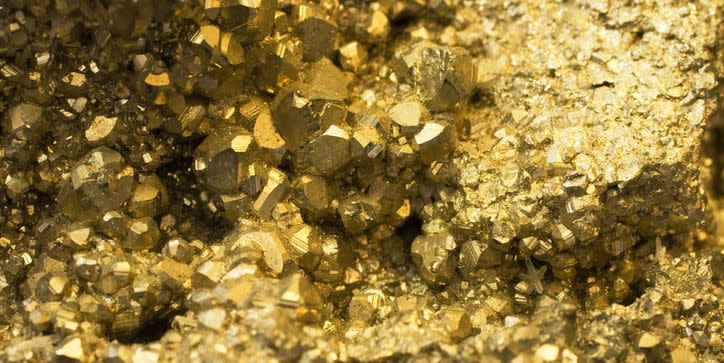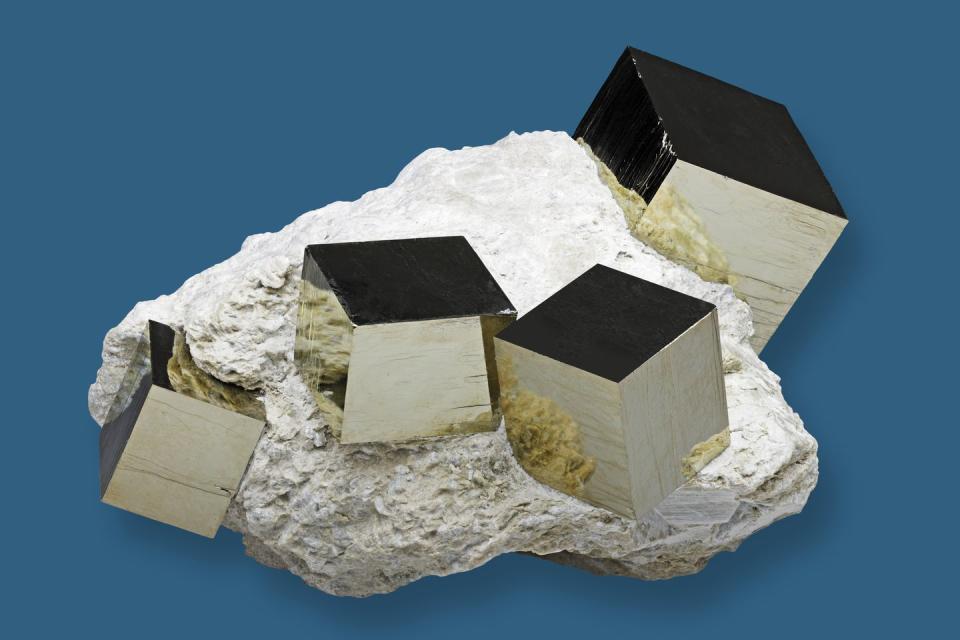Fool's Gold Has a Purpose After All

New research details the first ever conversion of a non-magnetic material into a permanent magnet using electricity.
The researchers seek cheaper, more plentiful magnetic materials to use in solar panels.
Electricity and electrolytes effectively rearrange the surface chemistry of the iron sulfide.
Iron sulfide, better known as pyrite or fool's gold, could have a new lease on the high life after researchers turned it into a magnet using an electrical treatment. Physicists and chemical engineers from the University of Minnesota and more collaborated on the new research, which they say points the way toward a new kind of solar panel material made from abundant, low-cost sulfur.
University of Minnesota explains in a statement:
“In the study, the researchers used a technique called electrolyte gating. They took the non-magnetic iron sulfide material and put it in a device in contact with an ionic solution, or electrolyte, comparable to Gatorade. They then applied as little as 1 volt (less voltage than a household battery), moved positively charged molecules to the interface between the electrolyte and the iron sulfide, and induced magnetism.”

What’s neat is how this reaction itself mimics magnetism. The iron sulfide is touched to the ionic solution and then gently electrified, and in the ensuing reaction, the positively charged (and magnetically viable) molecules gather along the electrified electrolyte surface.
Overall, it’s kind of like using an electromagnetic process, but in this case, the change is permanent and doesn’t require further current. The researchers say their findings are the first time electricity has induced a permanent change in magnetism. Lead researcher Chris Leighton explains:
"By applying the voltage, we essentially pour electrons into the material. It turns out that if you get high enough concentrations of electrons, the material wants to spontaneously become ferromagnetic, which we were able to understand with theory. This has lots of potential. Having done it with iron sulfide, we guess we can do it with other materials as well."
📩 Make your inbox more awesome.
The experiment resulted from a research group whose two broad interests intersected at one critical point. They want to improve photovoltaic solar cell technology by broadening the number of low-cost candidate materials and technologies, and they also research the process of inducing longer-lasting magnetism in (until now) materials with at least some magnetism to begin with. That field is called magnetoionics—magneto for magnets and ionics for the way we must rearrange the ions in order to create magnetism.
Keen-eyed observers may wonder why an iron compound isn’t magnetic to begin with, since iron is one of the most magnetic elements. Common magnetism is even shortened from ferromagnetism, referring specifically to iron. But when you add other elements, in this case sulfur, the effect is diminished or extinguished completely. In fact, the University of Minnesota chemistry department explains it beautifully alongside instructions for turning iron into iron sulfide:
“Before the reaction the test tube will be strongly attracted to a magnetic field due to the ferromagnetism of the elemental iron. After the reaction, assuming you completely use up the iron, the only magnetic attraction can come from the paramagnetic attraction of the iron(II) as part of the compound. Iron(II) is a d6 ion, which, depending upon the spin state (high spin or low spin), will have five or one unpaired electrons. Regardless of the spin state, paramagnetism is a much weaker force than ferromagnetism and so there will be a much smaller attraction of the test tube to a magnetic field.”
In the past, the only way to reverse the reduction in magnetism from pure iron to iron sulfide would be to separate the elements. Now, you might dunk it in an electrified Gatorade bath instead. (Preferred flavor? Icy Charge.)
You Might Also Like

 Yahoo Finance
Yahoo Finance 